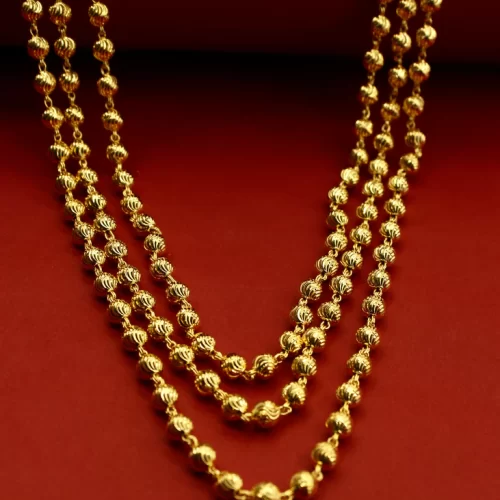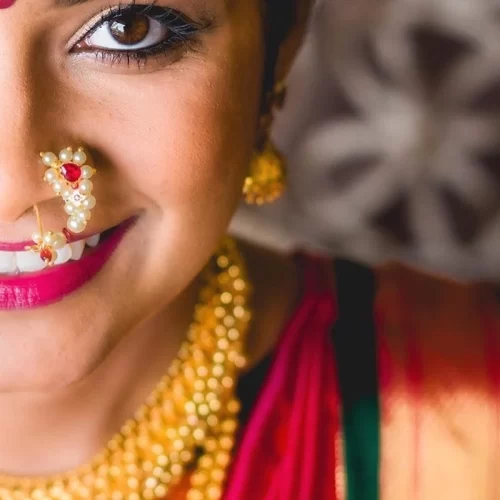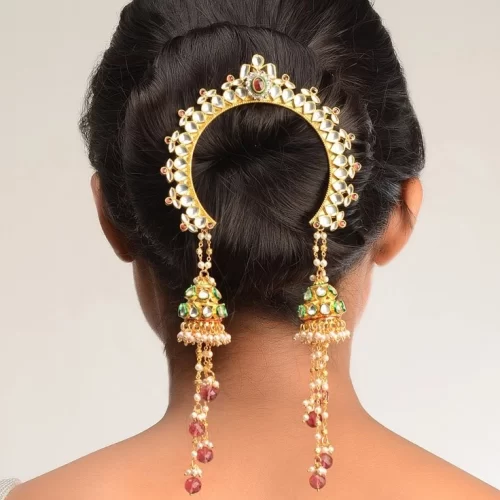Adorned in Tradition: Maharashtra's Exquisite Traditional Jewellery
Maharashtra is a land of rich cultural heritage, and its traditional Jewellery is a testimony to its vibrant and diverse culture. From intricate gold necklaces to stunning diamond-studded bangles, Maharashtra’s traditional Jewellery is a reflection of the region’s artistry, craftsmanship, and tradition. Every piece of Jewellery tells a unique story and holds a special place in the hearts of the people who wear them. In this article, we explore the exquisite traditional Jewellery of Maharashtra, unravelling the secrets of its design, symbolism, and cultural significance.
Mohan Maala

Mohan Maala is a type of traditional Indian Jewellery that originated in Rajasthan and Maharashtra, a northwestern state of India. The word “Mohan” means charming or attractive, and “Maala” refers to a necklace. As the name suggests, Mohan Maala is a stunningly beautiful necklace that is crafted using precious metals like gold and silver and adorned with exquisite gemstones such as rubies, emeralds, diamonds, and sapphires. The necklace comprises multiple strands of beads or pearls, which are often held together by an ornate centrepiece, which can be in the form of a peacock, elephant, or a floral design. Mohan Maala is often worn by women during weddings, festive occasions, and other cultural events, and it is considered a symbol of beauty, elegance, and tradition. With its intricate design and exquisite craftsmanship, Mohan Maala is a true reflection of the rich cultural heritage of Maharashtra and continues to be a coveted piece of Jewellery for women all over India.
Jodvi

Jodvi is a traditional Indian Jewellery piece worn on the feet. It originated in Rajasthan and is typically made of silver or gold. Jodvi is worn by women during weddings and other festive occasions, and it adds an element of beauty and grace to the overall attire. The design of Jodvi varies from simple to intricate, and it is often adorned with gemstones or embellished with intricate patterns. The Jewellery piece consists of a band that goes around the ankle and a chain or a string of beads that runs down to the toe. It is said that Jodvi not only enhances the beauty of a woman’s feet but also has therapeutic benefits, as it helps improve blood circulation and reduces swelling in the feet. With its unique design and cultural significance, Jodvi is a treasured piece of Jewellery that has stood the test of time and continues to be an essential part of traditional Indian fashion.
Brahmani Nath

Brahmani Nath is a traditional Indian Jewellery piece that is primarily worn by women in the state of Maharashtra. The Nath is a nose ring that is typically made of gold and is designed to be worn on the left nostril. The design of Brahmani Nath is intricate and often incorporates precious gemstones such as diamonds, rubies, and emeralds. The Nath is named after the Hindu goddess Brahmani, who is associated with power and wisdom. The Jewellery piece is an essential part of a Maharashtrian bride’s trousseau and is also worn on special occasions such as festivals and weddings. Brahmani Nath is considered a symbol of femininity and elegance and is believed to bring good luck and prosperity to the wearer. With its rich cultural significance and intricate design, Brahmani Nath is a treasured piece of Jewellery that embodies the essence of traditional Indian fashion.
Kolhapuri Thushi

Kolhapuri Thushi is a type of traditional Indian Jewellery that originated in the Kolhapur region of Maharashtra. Thushi means “small gold beads” in Marathi, and the Jewellery piece consists of multiple strands of these small gold beads woven together using a special technique. The necklace is typically short in length, resting on the collarbone, and is often adorned with a central pendant or a cluster of beads. Kolhapuri Thushi is typically made of 22-carat gold and is often embellished with intricate designs or gemstones such as pearls, rubies, and emeralds. The Jewellery piece is an essential part of a Maharashtrian bride’s trousseau and is also worn on festive occasions such as Diwali, Navratri, and other cultural events. Kolhapuri Thushi is considered a symbol of tradition and elegance and is highly coveted for its intricate design and exquisite craftsmanship. With its rich cultural heritage and unique design, Kolhapuri Thushi is a treasured piece of Jewellery that has stood the test of time and continues to be an essential part of traditional Indian fashion.
Ambada

Ambada is a traditional Indian Jewellery piece that is primarily worn by women in the state of Maharashtra. It is a hair accessory that is designed to secure a woman’s hair in a bun or a chignon. Ambada typically consists of a gold or silver base that is adorned with intricate designs, embellishments, and gemstones such as diamonds, rubies, and emeralds. The Jewellery piece is often passed down through generations as a family heirloom and is an essential part of a Maharashtrian bride’s trousseau. Ambada is not only a symbol of elegance and beauty but also signifies marital status and prosperity. The design of Ambada varies from simple to intricate, and it is often customised to suit a woman’s individual style and preference. With its unique design and cultural significance, Ambada is a treasured piece of Jewellery that has stood the test of time and continues to be an essential part of traditional Indian fashion.
Kaan

Kaan is a traditional Indian Jewellery piece that is worn by women in the state of Maharashtra. It is a type of earring that is designed to be worn on the earlobe and also covers the outer part of the ear. The design of Kaan is intricate and often incorporates precious gemstones such as diamonds, rubies, and emeralds. The Jewellery piece is an essential part of a Maharashtrian bride’s trousseau and is also worn on special occasions such as festivals and weddings. The Kaan is typically made of gold or silver and is adorned with intricate designs that make it stand out. The design of Kaan varies from simple to elaborate and is often customised to suit a woman’s individual style and preference. With its unique design and cultural significance, Kaan is a treasured piece of Jewellery that adds to the beauty and elegance of traditional Indian fashion.
Kolhapuri Saaj

Kolhapuri Saaj is a traditional Indian jewellery piece that originated in the Kolhapur region of Maharashtra. It is a necklace that is made up of multiple chains, each adorned with a different design and gemstones such as pearls, rubies, and emeralds. The centrepiece of the necklace is typically a large pendant that is crafted with intricate designs and embellishments. The necklace is often paired with matching earrings and is an essential part of a Maharashtrian bride’s trousseau. The Kolhapuri Saaj is crafted using 22-carat gold and is known for its exquisite craftsmanship and intricate design. The necklace is a symbol of tradition, beauty, and elegance and is worn on special occasions such as weddings, festivals, and other cultural events. With its unique design and cultural significance, Kolhapuri Saaj is a treasured piece of jewellery that has stood the test of time and continues to be an essential part of traditional Indian fashion.
Wrapping Up
Within the different jewellery styles in India, Maharashtra’s traditional jewellery is an integral part of its cultural identity, representing the region’s artistic legacy and rich heritage. The intricate designs, precious materials, and exquisite craftsmanship of these Jewellery pieces make them true works of art that are treasured by generations of Maharashtrians. From weddings to festivals and other cultural events, traditional Jewellery continues to play an important role in the lives of people in Maharashtra. As we celebrate the rich cultural legacy of Maharashtra’s traditional Jewellery, let us take pride in the region’s unique heritage and ensure that these treasures are passed down to future generations.
